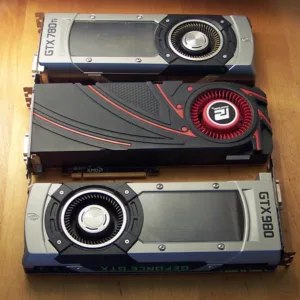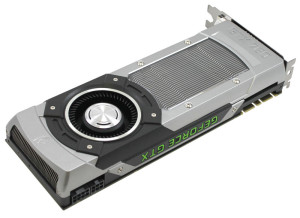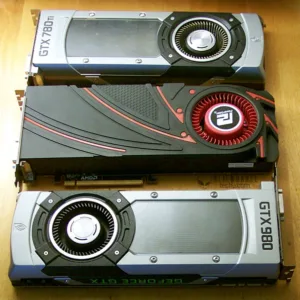(This evaluation was originally published by this author on Alienbabeltech in November and was subsequently lost in their database crash and has been restored here)
 As a follow up to ABT’s GTX 980 launch article, we have identified the three fastest gaming single-GPU cards – the GTX 980, the GTX 780 Ti, and the R9 290X. We originally tested them each at stock in 28 games, and only overclocked our GTX 980. At stock, the GTX 980 won decisively over the 290X, and marginally over the GTX 780 Ti. Now we’d like to also see how the overclocked GTX 780 Ti and the overclocked R9 290X compare with each other and with the overclocked GTX 980.
As a follow up to ABT’s GTX 980 launch article, we have identified the three fastest gaming single-GPU cards – the GTX 980, the GTX 780 Ti, and the R9 290X. We originally tested them each at stock in 28 games, and only overclocked our GTX 980. At stock, the GTX 980 won decisively over the 290X, and marginally over the GTX 780 Ti. Now we’d like to also see how the overclocked GTX 780 Ti and the overclocked R9 290X compare with each other and with the overclocked GTX 980.
Since we have a reference version of the 290X, a very capable PowerColor overclocked card, we are going to need to run it with extra voltage and with the fan at 100% to prevent throttling when it is overclocked +150MHz to 1150MHz core and +200MHz to 1450MHz on the memory. The GTX 980 is overclocked +200MHz on the core and +500MHz on the memory, while the GTX 780 Ti is overclocked +175MHz core/+400MHz memory – but they are run at stock voltage and fan profile since they don’t throttle like the 290X does.
We have pitted the PowerColor R9 290X OC against the GTX 780 Ti at least three times before, with the GeForce taking the crown. It takes a strongly overclocked R9 290X to match a GTX 780 Ti, and the GTX 780 Ti can also overclock well. This evaluation will feature the PowerColor card, and this time we shall overvolt, lock the fan speeds to 100%, and drop the ambient temperatures for each card to declare an overall performance winner.
The PowerColor R9 290X OC vs. the GTX 980 & vs. the GTX 780 Ti
 The reference version of the R9 290X is clocked up to 1000MHz while the PowerColor 290X OC Edition is clocked up to 1030MHz . Memory clocks are 1250MHz at stock GDDR5 5000 speeds. The regular R9 290X is priced rather right now, as AMD appears to be waiting to see if Nvidia has a good supply of GTX 980 and 970 video cards before they begin price cutting. At Newegg, there are no GTX 980s in stock, although they are generally priced at $550.
The reference version of the R9 290X is clocked up to 1000MHz while the PowerColor 290X OC Edition is clocked up to 1030MHz . Memory clocks are 1250MHz at stock GDDR5 5000 speeds. The regular R9 290X is priced rather right now, as AMD appears to be waiting to see if Nvidia has a good supply of GTX 980 and 970 video cards before they begin price cutting. At Newegg, there are no GTX 980s in stock, although they are generally priced at $550.
For example, the HIS R9 290X which is clocked at 1100MHz is priced at $680 after a $30 mail-in rebate, and it slower than the $550 reference GTX 980. AMD is bundling two games from their “Never Settle” bundle while Nvidia has no bundle with the GTX 980/970.
Being able to overclock the PowerColor R9 290X to 1150MHz puts it in the same category as the very fastest factory overclocked 290X cards which do not usually have much headroom left unless they are watercooled.
 The reference GTX 780 Ti can be found for as little as $449 and it is currently sold with a coupon for Borderlands: The Pre-Sequel as a bundle. We have already found that the stock 290X is faster than the GTX 780 and the TITAN, although the stock GTX 780 Ti slots above the mildly overclocked PowerColor 290X.
The reference GTX 780 Ti can be found for as little as $449 and it is currently sold with a coupon for Borderlands: The Pre-Sequel as a bundle. We have already found that the stock 290X is faster than the GTX 780 and the TITAN, although the stock GTX 780 Ti slots above the mildly overclocked PowerColor 290X.
What about overclocking?
Our evaluation sample of the reference GTX 780 Ti overclocks well on stock fan profile and stock voltage so that it performs significantly faster than the mildly overclocked PowerColor R9 290X. We are able to add +175MHz offset to the core and +200MHz to the memory. For GTX 980 results, we used the same overclocked results from our GTX 980 evaluation which used on a +200MHz offset to the core and +500MHz to the memory.
 Since we do not want any chance of our CPU bottlenecking our graphics, we are testing all of our graphics cards by using our Intel Core i7-4770K at 4.0GHz, 16 GB Kingston “Beast” HyperX DDR3 at 2133MHz, and an ECS Golden Z87 SLI/Crossfire motherboard. The Core i7-4770K at 4.0GHz is fast enough to differentiate even high-end video cards at high resolution and at high detail settings.
Since we do not want any chance of our CPU bottlenecking our graphics, we are testing all of our graphics cards by using our Intel Core i7-4770K at 4.0GHz, 16 GB Kingston “Beast” HyperX DDR3 at 2133MHz, and an ECS Golden Z87 SLI/Crossfire motherboard. The Core i7-4770K at 4.0GHz is fast enough to differentiate even high-end video cards at high resolution and at high detail settings.
Before we look at our test bed and run benchmarks, let’s check out test configuration.
Test Configuration
- Test Configuration – Hardware
- Intel Core i7-4770K (reference 3.5GHz, HyperThreading and Turbo boost is on to 3.7GHz; overclocked to 4.0GHz; DX11 CPU graphics), supplied by Intel.
- ECS GANK Domination Z87H3-A2X motherboard (Intel Z87 chipset, latest BIOS, PCIe 3.0 specification, CrossFire/SLI 8x+8x) supplied by ECS
- Kingston 16GB HyperX Beast DDR3 PC2133 RAM (2×8 GB, dual-channel at 2133MHz, supplied by Kingston)
- GeForce GTX 980, 4GB, reference clocks and also further overclocked, supplied by Nvidia under NDA
- Nvidia GTX 780 Ti, 3 GB reference design and clocks, supplied by Nvidia
- PowerColor R9 290X PCS+, 4GB reference designs at Uber clocks.
- Two 2TB Toshiba 7200 rpm HDDs
- Cooler Master Silent Pro Platinum 1000W power supply unit supplied by Cooler Master
- Thermaltake Water2.0 Pro watercooler, supplied by Thermaltake
- Onboard Realtek Audio
- Genius SP-D150 speakers, supplied by Genius
- Thermaltake Overseer RX-I full tower case, supplied by Thermaltake
- ASUS 12X Blu-ray burner
- HP LP 3065 2560×1600 thirty-inch LCD
Test Configuration – Software
- Nvidia GeForce 344.07 release drivers for the GTX 980, GTX 780 Ti. High Quality, prefer maximum performance, single display.
- AMD 14.7 RC Beta 7 Catalyst drivers for R9 290X at stock clocks and 14.9 WHQL for overclocked results. High Quality – optimizations off; use application settings
- Windows 7 64-bit; very latest updates
- Latest DirectX
- All games are patched to their latest versions.
- VSync is off in the control panels.
- AA enabled as noted in games; all in-game settings are specified with 16xAF always applied; 16xAF forced in control panel for Crysis.
- All results show average, minimum and maximum frame rates except as noted.
- Highest quality sound (stereo) used in all games.
- Windows 7 64, all DX9 titles were run under the DX9 render path; DX10 titles were run under DX10 render paths; DX11 titles under DX11 render paths.
The Benchmarks
Synthetic
- 3DMark 11
- Firestrike – Basic & Extreme
- Heaven 4.0
- The Witcher 2
- Borderlands 2
- Aliens: Colonial Marines
- Crysis
- STALKER, Call of Pripyat
- Civilization V
- Max Payne 3
- the Secret World
- Sleeping Dogs
- Sniper Elite V2
- Hitman: Absolution
- Far Cry 3
- CoD: Ghosts
- Tomb Raider: 2013
- Crysis 3
- BioShock: Infinite
- Metro: Last Light
- GRID 2
- Battlefield 4
- Splinter Cell: Blacklist
- ArmA 3*
- Total War: Rome II
- Batman: Arkham Origins
- Assassin’s Creed IV: Black Flag
- Thief
- Sniper Elite 3
- Watch_Dogs
- GRID: Autosport
This is the third time that we are benching with CoD: Ghosts, ArmA III, and Sniper Elite 3, and the second time with GRID: Autosport and Battlefield 4. All games tested are single player with the exception of the Secret World. We are still using Sniper Elite V2 and GRID 2 as a comparison for the last few times as they are being replaced by Sniper Elite 3 and GRID: Autosport as part of ABT’s regular 28 game benchmark suite. We did not have time to add Middle Earth: Shadows of Mordor, as it will become ABT’s newest benchmark and was just released this morning. Before we get to the GTX 980 performance charts, let’s look again at overclocking, power draw and temperatures for the R9 290X.
Overclocking, Noise and Temperatures
Overclocking the R9 290X is different than overclocking other Radeons. The Hawaii GPU runs so hot, that the fan speed plays a critical role in reaching the maximum overclock without throttling. 94C is the thermal limit that AMD has imposed, and the clocks drop when it is reached.
Uber mode is much louder and it allows a fan speed of 55% which keeps the Hawaii GPU from throttling. We always test all of our video cards after being “warmed up”. To get the highest performance from our PowerColor 290X manual overclock, we set the fan speed to 100% and we then look for the highest performance across our benchmark suite that does not throttle the GPU. We found that adding +150MHz to the core speed of the 290X kept our GPU mostly in the 1150MHz range with minimal throttling at 100% fan. We used MSI’s latest version of Afterburner to add +.1mV to stabilize it completely and we also needed cool ambient temperatures of below 75F to maintain our highest clocks.
The Hawaii core was actually stable beyond our +150MHz offset to over 1160MHz, but 100% fan was not enough to keep the hot-running GPU from throttling and performance was generally less overall than with trying to maintain 1150MHz. We also managed +200MHz on the memory, to raise the clocks from 1250MHz to 1450MHz. We lost stability at 1500MHz and 1450MHz provided the best overall performance for the memory.
As a last comment, benching the reference R9 290X at 100% fan is irritating. It is very much like gaming with a nearby hairdryer running non-stop on high. No closed headphones will block it completely, and you can easily hear the card running in the next room even with a door shut. In contrast, the fan of the GTX 780 Ti and the GTX 980 at 100% is acceptable; they are about as loud as the 290X running at 60%. The GTX 980/780 Ti fan frequencies are much less irritating even at 100%, it is more a “whoosh” of air instead of the droning noise of the 290X. At any rate, we did not adjust the voltage nor the fan profile for the GeForce cards.
Let’s head to the performance charts to see how the stock and overclocked to 1150MHz core PowerColor R9 290X OC compares with the overclocked GTX 980 at stock and overclocked, as well as against the stock and overclocked GTX 780 Ti.
Performance summary charts & graphs
Following are two summary charts of 28 modern PC games and 3 synthetic benches. The highest settings are generally chosen and it is DX11 when there is a choice; DX10 is picked above DX9, and the settings are generally ultra or maxed unless specified on the chart. Specific settings are listed on the charts. The benches are run at 1920×1080 and 2560×1600. Except for FireStrike and 3DMark 11, the results are given for average frame rates per second.
The first column shows the performance of the stock GTX 980 (Peak Boost 1265MHz) compared with its overclocked (+200MHz core/+500MHz memory) results (Peak Boost, 1452MHz) in the second column. The third column represents the Uber R9 290X at its stock clocks (up to 1000MHz clocks) and then in the 4th column, overclocked (+150MHz Core/+200MHz memory) to a peak of 1150MHz. The stock GTX 780 Ti is represented in the 5th column (1019MHz maximum Boost) compared with its overclocked results in the last column (+175MHz core/+400MHz memory) which allowed for a maximum Boost of 1182MHz.
In most cases, the overclocked GTX 980 sits just above the overclocked GTX 780 Ti, which in turn sits above the overclocked R9 290X, just as the reference clocked cards do. It will take much more than an 1150MHz Hawaii core clock to beat a modestly overclocked GTX 780 Ti or especially an overclocked GTX 980. The charts give the rankings very clearly. The currently rather expensive R9 290X OC loses to the $449 GTX 780 Ti and especially to the $550 GTX 980. Maximum overclocking does not change any positioning, and the R9 290X maximum overclock is still throttled by a very loud 100% fan in a cool room.
We get typically good scaling with the GTX 780 Ti and the GTX 980 as there is very little thermal throttling, even with the fan running at automatic profile. Some games do not scale well at 1920×1080 as Core i7-4770K at 4.0GHz is not fast enough, so we need to mostly focus on 2560×1600 results. On the other hand, we mostly see good scaling results for the R9 290X, but in some games there is very little increase from raising the clocks, and occasionally, we even see negative results. This is because even with the 290X fan maxed out at 100% in a cool room, it is not quite enough to keep the GPU below 94C, and throttling is still evident.
Let’s head to our conclusion.
Conclusion
This has been quite an interesting exploration for us in evaluating the overclocked and stock PowerColor R9 290X OC versus the stock and overclocked GTX 780, and versus the stock and overclocked GTX 780 Ti. The 290X did well performance-wise but slotting below the reference GTX 780 Ti, and well below the GTX 980. From looking at performance, the 290X appears to be generally priced too high compared to the GTX 980 at $550 and to the GTX 780 Ti priced at $450. AMD currently has two games bundled with its 290X while the GTX 780 Ti comes with Borderlands: The Pre-Sequel, and the GTX 980 has no game bundle as it is brand new.
We see good overclockability when the PowerColor R9 280X is overclocked beyond 1030MHz, and it scales well in performance. Unfortunately, the trade off for successfully overclocking the 290X is a lot of fan noise. The reference version of the 290X cannot be recommended unless it is purchased with D-i-Y watercooling in mind. Unfortunately, they are a contrast – the GTX 980/780 Ti are quiet at maximum overclock while the Uber R9 290X is loud, nevermind overclocked.
The Conclusion:
- The GTX 980 is the best performing single-GPU card, followed by the GTX 780 Ti – stock or overclocked.
We are looking forward to testing a watercooled version of the R9 290X to see if it can improve on performance by overclocking without throttling beyond 1150MHz.
Stay tuned, there is a lot coming from us at ABT. You can expect a performance evaluation of Middle Earth: Shadows of Mordor this week as it will become ABT’s latest benchmark! We are working on a Kingston 240GB mSATA evaluation using it as a cache drive, and a FURY Cloud headset is on the way for evaluation to ABT HQ. And don’t forget to check our Forums. ABT forum tech discussions are among the best to be found anywhere! We gave away a free copy of Shadows of Mordor this morning to a lucky ABT forum member.
Happy Gaming!